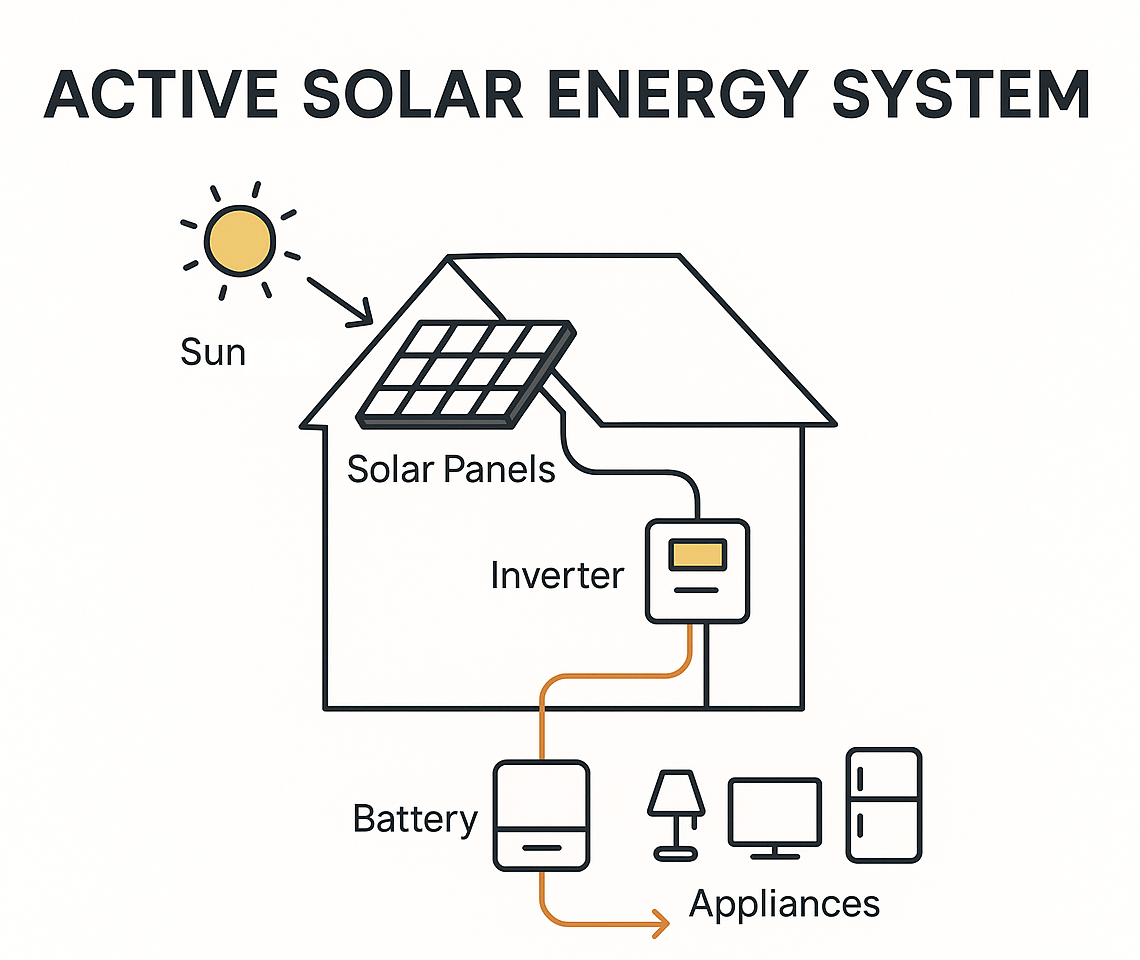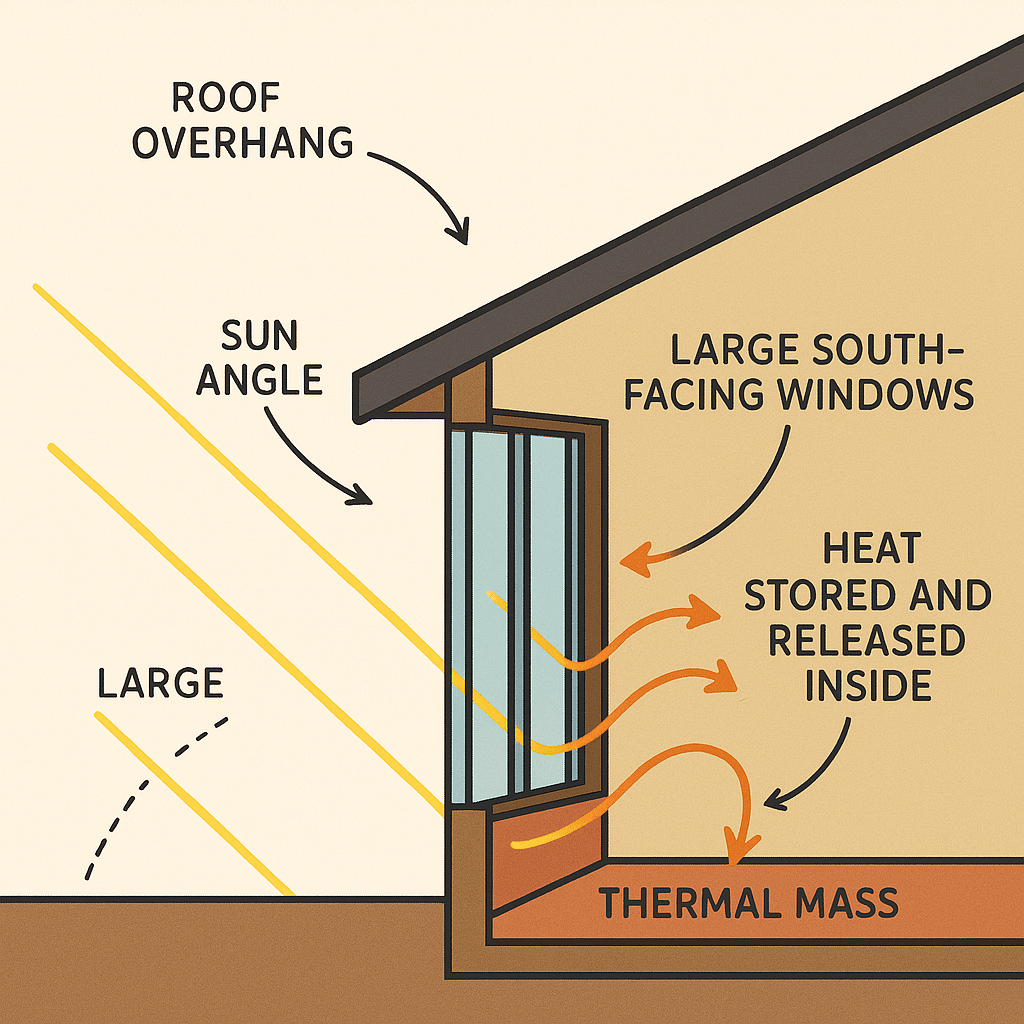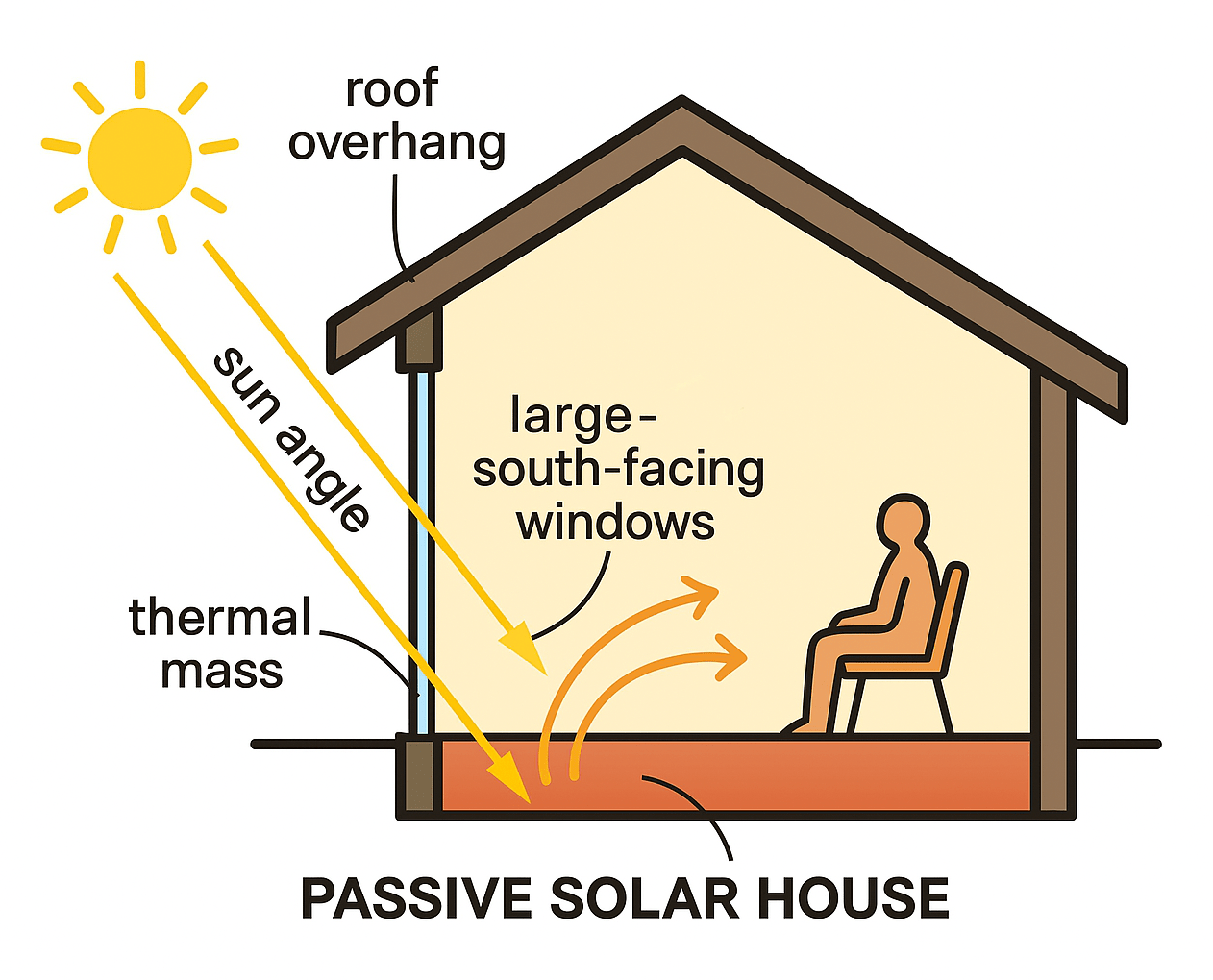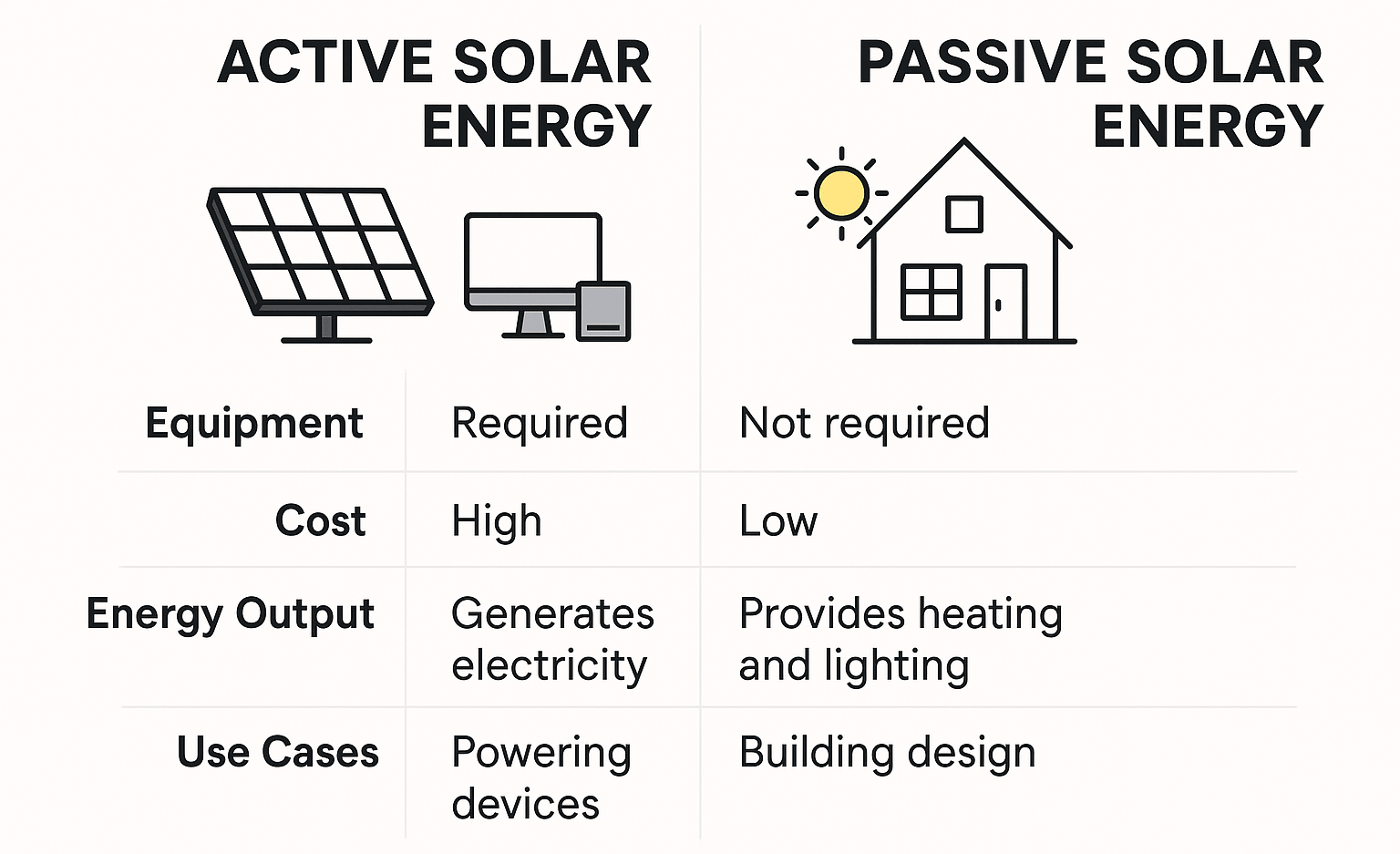The sun doesn’t send a bill and yet, it powers our world every single day.
Solar energy is the power we capture from the sun’s rays and convert into usable heat or electricity. As a clean, renewable, and abundant resource, it offers a sustainable alternative to fossil fuels—reducing greenhouse gas emissions and lowering long-term energy costs.
There are two main ways solar energy is harnessed: active and passive solar energy.
- Active solar energy
- Passive solar energy
In this guide, you’ll explore the passive vs active solar energy, how each system works, real-world examples, their advantages and disadvantages, and how to choose the right approach for your home or business.
Active Solar System
Active solar energy refers to a solar energy system that uses mechanical or electrical devices to actively collect, store, and convert sunlight into usable energy electricity or heat. These systems rely on external components such as pumps, fans, or photovoltaic (PV) panels, making them highly efficient for energy production across homes, businesses, and industrial settings.
How Does Active Solar Energy Work?
Active solar energy systems operate by capturing solar radiation using solar panels or thermal collectors and transforming it into electricity or heat using specialised technologies.
- Controllers to regulate energy flow
- Storage systems (like batteries or tanks)
- Converters such as inverters for electricity use
There are two primary types : These systems operate through advanced solar technologies like PV panels and thermal collectors, supported by government-led R&D programs.
- Photovoltaic (PV) Systems: A solar PV system converts sunlight directly into electricity using solar panels made of semiconductor materials. PV panels are the most common type of active solar energy collection used in residential and commercial settings.
- Solar Thermal Systems: These use solar collectors such as evacuated tubes or flat-plate collectors, to absorb sunlight and heat water or air. This method is often used for solar water heating, space heating, or even large-scale applications like concentrated solar power (CSP) plants.
Active solar systems are a practical solution for producing clean energy and can be scaled for small households or large utility projects. Compared to passive solar energy systems, active setups require more equipment and maintenance but offer greater output flexibility.
Many modern buildings are now using Building Integrated Photovoltaics (BIPV), solar panels built into windows, roofs, or facades. These systems generate electricity while blending into the architecture, helping urban buildings produce power without extra space.
Advantages of Active Solar System
Active solar systems offer several clear benefits, especially for homes and businesses seeking consistent, high-output energy solutions.
- Consistent Power Output: PV systems supply steady, renewable electricity, even during less sunny days making them dependable for year-round use. This makes them ideal for powering appliances, lighting, and devices year-round.
- Scalable and Flexible : Suitable for homes, businesses, and large solar farms easily tailored to different power demands.
- Efficient Use of Solar Technology : Technologies like inverters and thermal collectors help maximise energy capture and storage.
- Eligible for Incentives: Many qualify for federal and state programs like the Solar Tax Credit, rebates, and net metering, which lower overall installation costs.
- Lower Carbon Footprint: Active solar systems minimise the use of polluting fuels, helping meet sustainability and climate goals.
- Widely Proven and Versatile : From powering rural homes to supporting hospitals and schools, active solar energy examples prove their reliability across sectors.
These performance-based benefits often position active systems as the preferred choice in the active and passive solar energy where energy output and reliability are top priorities.
Disadvantages of Active Solar System
While active solar systems are effective, they do come with some trade-offs:
- Higher Upfront Cost : Equipment like panels, inverters, and controllers makes these systems more expensive to install.
- Maintenance Needs : Moving parts and electronics require periodic checks, especially in solar thermal setups.
- Weather-Dependent Output : Energy production can drop on cloudy days or during winter, often requiring grid or battery backup.
- Space Limitations : Large arrays may not suit small roofs or older structures without reinforcement.
- Manufacturing Impact : Producing components like PV panels and batteries has its own environmental footprint.
In the active vs passive solar energy comparison, these factors make passive systems more appealing for low-cost, low-maintenance heating needs.
Passive Solar System
A passive solar energy system harnesses sunlight without using mechanical or electrical devices. Instead of converting sunlight into electricity, it captures and distributes solar heat through building orientation, materials, and design features.
Unlike active systems that rely on equipment, passive solar works naturally for space heating and lighting.
How Does Passive Solar Energy Work?
It works by allowing sunlight to enter a building during the day, storing that heat in thermal mass (like concrete, brick, or water), and slowly releasing it when temperatures drop.
This heating process happens automatically, without moving parts or electricity. This is known as thermal mass design, which helps regulate temperature inside the house.
There are three main types of passive solar energy designs:
- Direct Gain: Sunlight enters through south-facing windows and heats interior surfaces directly.
- Indirect Gain (Trombe Wall): A thermal wall collects and slowly radiates heat into the living space.
- Isolated Gain (Sunspace): A separate area, like a sunroom, collects solar heat and transfers it into the main space.
This design approach is especially useful in colder climates or off-grid environments where simplicity, efficiency, and sustainability matter.
Advantages of Passive Solar System
Passive solar systems offer simple, sustainable benefits—especially for heating-focused applications:
- Low Installation Cost : No need for panels, inverters, or wiring—just smart architectural design and materials.
- Zero Operational Energy Use : Since there are no mechanical parts, the system works naturally without electricity.
- Minimal Maintenance : With no moving components, passive designs require little to no upkeep over time.
- Improves Energy Efficiency : Well-designed passive homes reduce the need for artificial heating and lighting.
- Environmentally Friendly : Uses sunlight directly without emissions, making it one of the cleanest heating methods.
- Ideal for Off-Grid or Rural Settings : Works well where electrical infrastructure is limited or unavailable.
In the context of passive vs active solar energy, passive systems excel in simplicity, affordability, and long-term sustainability.
“Our home in Shimla was designed using passive solar principles, large south-facing windows, insulated walls, and concrete flooring. Even in winter, we barely use heaters now. It’s been a game-changer for comfort and savings.”
— Ramesh Malhotra, Homeowner, Shimla (Himachal Pradesh)
Disadvantages of Passive Solar System
While passive solar systems are simple and sustainable, they do have some limitations:
- Limited to Heating Only : Passive systems can’t generate electricity—they’re primarily used for space heating and daylighting.
- Design Dependency : Performance relies heavily on building orientation, window placement, and materials. Retrofits can be challenging.
- Weather Sensitivity : On cloudy days or in poorly insulated homes, heat gain and retention drop significantly.
- Limited Adjustability: Passive designs are fixed once built, offering less flexibility in managing indoor temperature or sunlight levels.
- Climate-Specific Use: Passive systems perform best in cool, sunny areas and may be less effective in tropical or high-humidity zones.
These factors often tip the scale toward active systems, especially when electricity production or climate adaptability is essential.
What Is a Passive Solar House?
Many net-zero homes use passive solar methods as explained earlier, passive solar systems use thermal mass, south-facing windows, and smart design to naturally regulate temperature. Passive solar houses reduce heating costs and energy use.
Passive solar homes are also encouraged in green building certifications like LEED (Leadership in Energy and Environmental Design) and India’s GRIHA rating system. These programs reward energy-efficient building designs that cut carbon footprints.
Expert Tip : “Designing a passive solar home in India involves more than just south-facing windows. Materials, roof angle, insulation, and ventilation all play a role, especially in diverse climates like Rajasthan vs. Kerala.”— Anjali Nair, Green Architect, Bengaluru
Benefits of a Passive Solar House:
- Energy-efficient heating without relying on external energy sources
- Lower utility bills and reduced dependence on fossil fuels
- Sustainable design with minimal environmental impact
- Enhances indoor comfort using sunlight, airflow, and thermal storage
Common examples of passive solar energy in homes include sunrooms, trombe walls, and strategically placed skylights.
Difference Between Active and Passive Solar System
Understanding the key differences between active and passive solar energy systems helps determine which is best suited for your needs. Below is a side-by-side comparison based on core factors:
| Factor | Active Solar System | Passive Solar System |
| Energy Output | Converts sunlight into electricity or heat using equipment | Uses sunlight directly for space heating and lighting |
| Components | PV panels, pumps, fans, inverters, thermal collectors | Windows, thermal mass (walls, floors), building orientation |
| Installation Cost | Higher due to advanced components | Lower – relies on architectural design |
| Maintenance | Requires periodic upkeep due to mechanical/electrical parts | Minimal, with few or no moving parts |
| Control | High – systems can be automated and adjusted | Low – performance depends on fixed design choices |
| Applications | Best for electricity generation, large-scale heating, commercial setups | Best for passive heating in homes or off-grid cabins |
| Suitability | Performs well in most climates with adequate sunlight | Best in sunny, cooler regions with optimal building design |
Is Active Solar Energy Better than Passive Solar Energy?
There’s no one-size-fits-all answer! It depends on your specific electricity requirements and goals.
- If your priority is electricity generation, then active solar systems are a better choice (especially PV panels). They’re designed to convert sunlight into power for appliances, lighting, and more.
- On the other hand, if your goal is cost-effective space heating or daylighting, passive solar energy is the better choice. It uses natural sunlight and heat without mechanical parts, making it affordable and low-maintenance.
Can You Combine Both?
Yes, many energy-efficient buildings use a hybrid approach, combining active solar energy collection for electricity or water heating with passive solar design for natural lighting and heat retention. This strategy maximises efficiency while reducing energy costs and environmental impact.
Case Study: Sustainable School in Ladakh Using Hybrid Solar Design
In Leh, Ladakh, the Students’ Educational and Cultural Movement of Ladakh (SECMOL) campus uses a hybrid approach, passive solar design with thick mud-brick walls and south-facing windows for heat, and active solar panels for lighting and computer labs.
The campus remains warm in freezing temperatures without electric heaters and saves thousands in energy costs each year.
This real-world example proves that combining both solar approaches offers maximum efficiency in remote, cold Indian regions.
Are There Any Government Incentives for Installing Active or Passive Solar Energy Systems?
Yes — India has become a global leader in solar adoption. India as well as governments around the world are providing several incentives to make both active and passive solar energy systems more affordable and accessible.
These programs help cut upfront costs, improve ROI, and encourage clean energy adoption, there are several government-backed programs available:
1. PM Surya Ghar: Muft Bijli Yojana (2024–25)
A central rooftop solar subsidy scheme offering:
- Up to ₹78,000 subsidy for a 3 kW system
- Free electricity up to 300 units/month for eligible households
- Applies to active solar energy systems (grid-connected rooftop PV)
“I installed a 3kW rooftop solar system under the PM Surya Ghar scheme in Pune. The subsidy helped a lot, and now my electricity bills are nearly zero. We even feed excess power back to the grid through net metering.”
— Priya Kulkarni, IT Professional, Pune (Maharashtra)
2. State-Level Rooftop Solar Subsidies
Many Indian states (e.g., Gujarat, Kerala, Maharashtra) offer additional subsidies on top of the central scheme, especially for residential and MSME sectors.
- Focuses on PV installation and solar water heaters
- Often managed through state DISCOM portals
3. Net Metering Policy
Allows consumers to export surplus solar electricity back to the grid and receive billing credits.
- Applies exclusively to active solar energy collection systems (PV)
- Regulated by state electricity regulatory commissions (SERCs)
4. Accelerated Depreciation for Businesses
Commercial and industrial users can claim up to 40% depreciation(Offers major tax savings) in the first year of solar asset purchase.
5. Support for Passive Solar Energy in Green Building Codes
While passive systems don’t receive direct subsidies, they’re promoted through:
- Eco-Niwas Samhita (ENS) a building energy code that encourages passive solar energy advantages like daylighting, orientation, and ventilation
- GRIHA & IGBC national green building rating systems that reward passive design strategies
Conclusion: Choosing Between Active and Passive Solar Energy
Active and passive solar systems each offer unique advantages, what works best depends on your specific energy needs, budget, and building design.
- Active solar energy systems are ideal when your goal is to generate electricity or hot water using technologies like PV panels or solar collectors. Though they require a higher upfront investment and maintenance, they offer scalable, reliable output—perfect for homes, businesses, and large-scale use.
- Passive solar energy systems, by contrast, are low-cost, low-maintenance, and best suited for natural space heating and lighting. Using smart design rather than mechanical systems, they enhance comfort while lowering long-term energy demand.
For many, the most efficient and sustainable solution is a hybrid approach, combining both systems to maximise energy savings, improve indoor comfort, and decrease environmental impact.
Frequently Asked Questions (FAQs)
What’s the difference between active and passive solar energy?
Active systems use equipment like solar panels and pumps to generate electricity or heat. Passive systems use building design like south-facing windows and thermal mass, to naturally heat or light a space.
Is passive solar energy more affordable?
Yes. Passive systems are typically cheaper since they don’t require costly equipment or maintenance, just smart design and orientation.
Can I combine both systems?
Definitely. Many energy-efficient buildings use active solar for electricity and passive solar for heating and daylighting.
Do passive solar homes still need electricity?
Yes, they still use electricity for appliances and lighting. But passive design reduces the overall energy demand.




